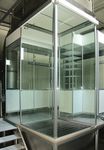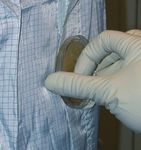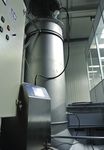Requalification of a cleanroom garment system
←
→
Page content transcription
If your browser does not render page correctly, please read the page content below
Requalification of a
cleanroom garment system
taking into account the typical signs of ageing
B
ased on a question during an audit by the authorities at a pharmaceutical com-
pany regarding qualification data for cleanroom garments of cleanroom zone
A/B, this cleanroom garment was requalified* as part of a joint project. The
people involved report here on the most important results and their interpretation.
* At the time of the audit by the authorities, the cleanroom garments had already been in use in cleanroom zone A/B for several years. The correct func-
tionality of the cleanroom garments was indirectly verified by means of microbiological personnel and environmental controls, but an initial qualification
of the cleanroom garments according to current requirements (or: interpretation) was not available. Due to the already established use of the cleanroom
garments, this study is referred to as a requalification of the cleanroom garments.tamination of the product are designed in The relevant cleanroom garment
such a way that contamination of the product system of the pharmaceutical
can be ruled out. Of course, the production manufacturer involved in this
personnel pose a high microbiological and project is specified as follows:
particulate contamination risk. One way of
reducing the contamination risk posed by P 2-piece cleanroom-compatible intermedi-
personnel is to use cleanroom garments as ate clothing, consisting of a long-sleeved
the only filters between people and the pro- top and trousers, plus
duct. Consequently, cleanroom garments are P 3-piece outerwear consisting of a hood,
of particular importance. The selected clean- coverall and overboots.
room garment as an essential component of
the contamination control strategy must the- The intermediate clothing is made of a clean-
refore be checked/qualified, evaluated and, if room-compatible material woven from 100%
necessary, optimised. polyester microfibre filaments. The outerwear
is made of a material consisting of 98% poly-
In 2018/2019, an international pharmaceuti- ester and 2% carbon, which has proven itself
cal producer as a user of cleanroom garment, in cleanroom applications for many years.
the cleanroom garment manufacturer Dastex
with its site in Muggensturm (Germany) and The supplementary components of the cle-
the textile service provider Initial with its site anroom garment system include cleanroom-
in Reutlingen (Germany) took a closer look suitable socks, defined cleanroom shoes, cle-
at the question of how long cleanroom gar- anroom goggles, non-woven under cap and
ments (for sterile production in cleanliness disposable face mask, as well as two pairs of
zones A/B at a Swiss site of the pharmaceu- sterile gloves, each with long cuffs (length: 12
tical producer) can be used. As part of a joint inches) that can be pulled over the sleeves of
project, the aim was to study how cleanroom the coveralls.
garments behave over the maximum defined
number of wearing, decontamination and The maximum number of wearing, deconta-
sterilisation cycles. In more precise terms: mination and sterilisation cycles for outer-
whether they change qualitatively over the wear is defined as 60 and for over boots as
period of use. 40 (note: due to mechanical stresses during
the decontamination process caused by the
The aim was to obtain reproducible boot soles, wear-out is higher for overboots
values for the following parameters than for outerwear).
under conditions that are as close to
practice as possible: The clothing manufacturer Dastex has well-
founded technical data that also includes
P Airborne particle emission from people signs of ageing (caused by recurring repro-
wearing cleanroom garment of different cessing. In addition, Dastex published a study
phases of ageing in 2017 on the signs of ageing after 60
P Viable contamination at defined sampling decontamination and sterilisation cycles –
1. Introduction points on the outside of persons in a but without wearing the cleanroom gar-
cleanroom garment (textile surface) ments in between (Alterungserscheinung ste-
How often can a cleanroom garment riler Reinraumbekleidung, ReinRaumTechnik
be used? A question that is asked more and The cleanroom garment system defined at 1 / 2017, Wiley). The results of this study
more frequently in audits and, in many cases, the pharmaceutical manufacturer for sterile did show a decrease in filtration efficiency;
cannot necessarily be answered immediately. production in cleanliness zones A / B was however, this was by no means to an extent
The background to this question is the easily introduced there several years ago and has that could result in a negative microbial or
comprehensible finding that the performance become well established since then. The particulate impact on the environment.
of a washable cleanroom garment decreases results from microbiological personnel moni-
over time with the increasing number of toring (surface checks on the outside of the
decontamination (=washing & drying) with cleanroom garments at the end of the stay in 2. Material and methods
subsequent sterilisation cycles, as well as cleanliness zones A/B) showed only a small
wear cycles, due to age-related effects. This number of warning and action limit violations For a comparative study – cleanroom garment
applies all the more if the clothing is addi- since the introduction of this cleanroom gar- in new condition versus cleanroom garment
tionally sterilised. The contamination control ment system and was therefore interpreted with a maximum number of reprocessing
strategy required in the draft (2020) of the as a reliable cleanroom garment system. (washing/sterilising) with an intervening use
new Annex 1 (GMP Guideline) also demands However, the qualification of this cleanroom (wearing) – the use of the Body-Box method
that all parameters that could result in con- garment system was missing until now. with constant ambient conditions is appro-
2PRequalification of a
cleanroom garment system
Body-Box Measuring system BioTrak® Contact plate test
priate. The basics of the Body-Box method are P During the movement programme: Three age conditions of the clean-
described in an American recommendation room garment were compared:
• Measurement of particle release
practice (IEST RP-CC003.4). The Body-Box
(airborne; Optical Particle Counter;
system is described in detail in the publica- 1. New condition ➜ cleanroom garment
28.3 L sample volume per minute;
tion „Body-Box-Test, eine Testmethode auf was professionally washed and sterilised
using BioTrak® and
dem Prüfstand“ (ReinRaumTechnik 2/ 2004, three times (to remove potential residual
• Measurement of the release of viable
GIT-Verlag). The environmental conditions in substances from the fabric).
contaminants (airborne; laser-induced
the Body-Box used correspond to those of a 2. Final condition ➜ cleanroom garment
fluorescence; 28.3 L sample volume
cleanliness zone ISO 4 (ISO 14644-1). that has reached the specified maximum
per minute; using BioTrak®)
number of wear cycles (60/40 cycles with
Within the framework of this study, which a maximum of 3.5 hours wear time) incl.
P Before leaving the Body-Box, the bacterial
was carried out in the Body-Box of the washing and sterilisation cycles (123 °C for
count on the outside of the cleanroom
company Dastex, the following activities of 30 min.)
garment is checked by means of contact
a person dressed in the cleanroom gar- 3. Safety buffer ➜ cleanroom garment
plate tests at 20 measuring points distri-
ment described (in different states of age) that has reached the specified maximum
buted over the hood, coverall and over-
were accompanied by microbiological mea- number of wearing cycles (60 / 40) incl.
boots:
surements and particle measurements. The decontamination and sterilisation cycles
measurements were intended to test the • 1x forehead (123 °C for 30 min.) has been decontami-
permeability or retention capacity of the cle- • 1x cheek nated and sterilised a further 20 times, but
anroom garment with regard to particulate • 2x abdomen without wearing the cleanroom garments in
and microbial contamination. • 8x arms (2x upper arm and between. These additional decontamination
2x lower arm each) and sterilisation cycles of the cleanroom gar-
A person trained in the correct don- • 4x legs (1x front thigh and ment was intended to represent a worst-case
ning of cleanroom garment perfor- 1x back thigh each) scenario, on the basis of which the perfor-
med the following activities in the • 2x boots (1x per boot) mance of the garment concept was also to be
Body-Box: • 1x bottom tested beyond the defined final cycle number.
• 1x chest
P Entering the Body-Box For each ageing stage, ten sets of garments
P Acclimatisation time in the Body-Box The BioTrack® real-time viable particle coun- were examined both for the analysis in the
without movements ter enables the detection of the total particle Body-Box and for the determination of the
P Start of the defined movement program- count of airborne particles as well as a diffe- residual contamination levels, in order to
me (alternating walking movements and rentiation into airborne particles and airbor- obtain a sufficient data basis for a statistical
standing still). These activities were to ne viable particles based on biofluorescence. evaluation of the results.
simulate wearing the cleanroom garment. The microbiological analyses were incubated
at 30 – 35°C for 5–7 days and analysed
Phase Duration
with regard to the total bacterial count. In 3. Results
addition, the residual contamination levels
Acclimatisation time 1 – 10 min of the reprocessed cleanroom garments were 3.1 Residual contamination values
(Standing) determined prior to sterilisation with the The determination of the residual contami-
Standing 5 min help of the suction method in accordance nation levels by the laundry showed that
with ASTM-F51. In this method, air is sucked the levels – even with increasing age of the
Walking 5 min
through the cleanroom fabric by means of a garments – remained approximately constant
Standing 10 min particle measuring device; existing particles and were always well below the typical limits
Walking 10 min are thereby loosened from the fabric and (less than 1,000 particles ≥ 5 µm / ft2) accor-
Standing 5 min
measured. In total, the following measuring ding to ASTM F51.
points were defined: coverall (chest, upper
Walking 5 min arm, abdomen, front thigh, back thigh); hood 3.2 Microbiological results
Table 1: Movement programme: (forehead, cheek (mouth area); boots (at the The analysis of the microbiological load on
activities performed in the Body-Box top of the shaft). the outside of the cleanroom garments was
F3● 0-cycles
Requalification of a
cleanroom garment system ● 60-cycles
CFU
CFU
carried out by the pharmaceutical manufac-
turer. For the statistical analysis, the results
of the individual test points from the out-
side of the cleanroom garment were not
considered separately, but were combined
into one group. Figure 1 shows the individual
data with the box plot of the clothing sets
with 0 and 60 resp. 40 decontamination, 0-cycles 60-cycles
sterilisation and wearing cycles with 0 and 60 Figure 1: Microbial count analysis of the Cycle
outside of the garment (output = colony
resp. 40 decontamination, sterilisation and forming unit) of the garment sets (0 and 60 resp. 40 decontamination, sterilisation
wearing cycles. and wearing cycles) with overlaying box-plots.
The statistical analysis of the cleanroom gar- The data of the particle measurements with The statistical of the particle measurements
ments with 0 and 60 or 40 cycles was carried particle size ≥ 0.5 µm are subject to a log-nor- with a particle size ≥ 5 µm (0 and 60 resp. 40
out using a generalised linear model (model mal distribution. For this reason, the data of decontamination, sterilisation and wearing
for negative binomial distribution) due to the the particle measurements (0 and 60 resp. 40 cycles) was performed using a generalised
high occurrence of 0 CFU events. In addition, decontamination, sterilisation and wearing linear model (model for negative binomial
a chi-squared test was used to check whe cycles) were log transformed and subsequent- distribution) due to the high occurrence of 0
ther there was an association between the ly compared with each other by means of a particle events. In addition, a chi-squared test
two ageing states. The determined bacterial 2-sample T-test for significance (p < 0.05)). was used to check whether there was an asso-
counts were categorised according to the ciation between the particle measurements of
defined action limit for cleanroom garments No significant difference (p = 0.1855 > 0.05) the different ageing states. The determined
into > 5 CFU (YES, contamination) and ≤ 5 was found between the particle measure- particle counts were categorised into particles
CFU (NO, no contamination). ments (particle size ≥ 0.5 µm) of the clothing present (YES, contamination) and no particles
with 0 and 60 resp. 40 decontamination, present (NO, no contamination).
The results of the generalised linear model sterilisation and wearing cycles. As a result,
indicate that there is no significant diffe- the new garments are comparable to the The results of the generalised linear model
rence between the two garment sets (0 garments with 60 or 40 decontamination, indicate that there is a significant difference
and 60 resp. 40 cycles) (p = 0.469 > 0.05). sterilisation and wearing cycles in terms of between the two garment sets (0 and 60
Furthermore, no association between the two particle release (particle size ≥ 0.5 µm). resp. 40 decontamination, sterilisation and
garment sets (0 and 60 resp. 40 decontami- wearing cycles) (p < 0.05).
nation, sterilisation and wearing cycles) could Figure 3 shows the individual data with the
be detected by means of a chi-squared test. corresponding box-plot of the particle mea- In contrast, however, no association could be
Based on these results, it can be concluded surements of particle size ≥ 5 µm (0 and 60 detected by means of a chi-squared test be
that the garment sets with 0 and 60 or 40 resp. 40 cycles). tween the particle counts of particle size ≥ 5
cycles are microbiologically comparable.
3.3 Particle results 2,5
Using the BioTrak® system, the particle
counts in the return air were recorded during
2,0
the study of the cleanroom garments in the
Body-Box. A distinction was made between
the total airborne particles (total, T: analysed
1,5
Log T 0.5 µm
particle sizes ≥ 0.5 µm and ≥ 5 µm) and
viable particles (V: analysed particle ≥ 1 µm).
1,0
The results of the particle measurements of
particle sizes ≥ 0.5 µm and ≥ 5 µm were
statistically separately analysed due to the 0,5
different data distributions (particle sizes ≥
0.5 µm log normal distribution, ≥ 5 µm nega-
tive binomial distribution). 0,0
Figure 2 shows the individual log transfor- 0-cycles 60-cycles Each Pair
Student’s t
med data with corresponding box-plot of the 0.05
particle measurements with particle size ≥ Cycle
0.5 µm (0 and 60 resp. 40 washing, sterilisa- Figure 2: Log transformed data of the garments with 0 and 60 resp. 40 decontamination,
tion and wearing cycles). sterilisation and wearing cycles with overlaying box-plots.
4P● 0-cycles
Requalification of a
● 60-cycles cleanroom garment system
T 5 µm
T 5 µm
rements for use in cleanliness zones A/B and
that the specified maximum decontamination
and sterilisation cycles, including use of the
cleanroom garment in between, proved to
be adequate, since no statistically significant
difference could be demonstrated between
new cleanroom garments and cleanroom
0-cycles 60-cycles
garments after maximum use. Thus, the gar-
Figure 3: Particle measurements (particleCycle
size
≥ 5 µm) of the garment ment system investigated here could be suc-
with 0 and 60 resp. 40 cycles with box-plots drawn in. cessfully requalified for the pharmaceutical
producer. However, the results obtained in
this study cannot be easily transferred to
µm and the two garment sets (0 and 60 resp. ment sets of the different age states could be other – even if similar – cleanroom garment
40 decontamination, sterilisation and wearing carried out here. Figure 4 shows the data for systems.
cycles). Based on these different results, it is the age states 0 and 60 resp. 40 decontamina-
not possible to make a clear statement regar- tion, sterilisation and wearing cycles as a bar Different influencing factors can
ding comparability on the basis of particle chart. During the standing phases, no viable change the efficiency of a cleanroom
counts of particle size ≥ 5 µm. One possible particles could be detected with the counter. garment system
reason for this ambiguous result could be
that the studies of the cleanroom garment The analysis of the additionally prepared gar- 1) Each cleanroom textile has its own
presented here were „only“ carried out in a ment sets for the worst-case scenario could characteristics, which may change
Body-Box, which does not represent a genui- only be carried out with eight clothing sets. differently with increasing number of
ne cleanroom of zone A/B with associated Individual parts had defects on wear parts, washing, sterilisation and usage cycles.
personnel airlock, but rather the cleanroom which is why no further measurements could
2) Cleanroom compatible intermediate gar-
itself guarantees an ISO Class 4, while the be carried out with these. Therefore, the data
ment is a critical factor in the efficiency
associated personnel airlock „only“ repre- from the worst-case scenario was not used for
of a cleanroom garment system.
sents an ISO Class 7. Thus, the particle counts further comparison at this point. All in all, the
can only be evaluated to a limited extent. 60 and 40 cycles could be confirmed as good 3) Each cleanroom laundry processes
end points with the safety buffer examined. cleanroom garments under different
In the course of the generally relatively low conditions.
particle counts recorded, only isolated airbor-
4) Mechanical stress from the wearers can
ne viable particles could be detected with the 4. Discussion
vary greatly between different users and/
BioTrak® system. Due to the large number of
or application processes.
measuring points without findings, no statis- Based on the data, it can be seen that the
tical analysis of the comparability of the gar- established garment system meets the requi- 5) Disinfectants or other additional influen-
ces during wearing affect the durability of
the cleanroom garment.
6) The sterilisation process (duration, tempe-
rature, type) influences the durability and
efficiency of the cleanroom garment.
7) Wearing time can vary greatly between
different application processes.
8) The type and degree of contaminants to
be removed can have an impact on the
ageing characteristics of a cleanroom tex-
tile.
Consequently, each user should qualify/
requalify its own cleanroom garment system
according the relevant framework. Qualifying
the efficiency of the cleanroom garment
when new is not sufficient – qualifying the
efficiency of the cleanroom garment with the
maximum specified number of decontamina-
Figure 4: Airborne particles (T=total particle count, V=viable particle count as mean tion, sterilisation and wearing cycles should
value per minute separated by movement phase (n.d. = not detected) also be done.
F5Requalification of a
cleanroom garment system
In the case of an initial definition or a change 5. Forcast
of the cleanroom garment system, this is
of course not yet possible at the beginning. The question for data on the qualification/
Here, one can and must ultimately rely on requalification of cleanroom garment sys-
empirical values of other users, on study tems is likely to increase in the near future.
results – such as those described here – and Thus, as part of a follow-up study with
on the manufacturer‘s statements. If neces- another pharmaceutical producer, additional
sary, however, ageing phenomena can be fabric properties were tested with regard
simulated in a timely manner in order to be to ageing phenomena. For this purpose, the
able to make a better risk assessment. With recognised textile research institute DITV
increasing use of the cleanroom garments, Denkendorf was commissioned with the cor-
comparable tests, as described in this study, responding tests. The tests included, on the
are then possible under the specific frame- one hand, the roughening behaviour and the
work conditions – as part of the qualification tensile and tearing forces in the textile, as
process. Also essential for the interpretation well as the air permeability and the particle
and classification of results are the results retention capacity on the DITV filter test rig in
and trend data of the company‘s own routine accordance with VDI 3926.
microbiological bacterial count determina-
tions of the cleanroom and of the cleanroom The values determined in this new study
garments (environmental monitoring). If we using the Body-Box method in terms of
now combine these two elements: release of airborne particles and viable con-
taminations tended to agree with the fin-
P Qualification of the garment system, as
dings of the study discussed in this article.
well as
In particular, the data obtained at the textile
P Results and trend data of the microbio-
research institute DITV Denkendorf showed -
logical bacterial count determinations
no significant decrease in particle retention
of cleanroom and cleanroom garments
(after 60 resp. 40 (for overboots) washing,
during the use of cleanroom garments in
sterilisation and wearing cycles) – only very
cleanliness zones A/B,
slight deviations in the mechanical resilience
this results in the contamination control stra- of the fabric (after 60 washing, sterilisation
tegy required in Annex 1 (recognise / define, and wearing cycles) and confirmed the state- The authors
evaluate and control possible contamination ments on the defined washing, sterilisation C. Moschner (1), A. Stärk (2)
risks and optimise if necessary) and wearing cycles used here. H. Nagel (2), S. Gaza (1)
(1)
Dastex Reinraumzubehör GmbH & Co. KG
(2)
Novartis Pharma Stein AG
Article published (in German)
pharmind 1/2021
Revised version 2/2021
CWS Cleanrooms Deutschland
Dastex Reinraumzubehör
GmbH & Co. KG
Draisstr. 23
76461 Muggensturm
GERMANY
Telephone +49 7222 9696-60
Telefax +49 7222 9696-88
E-mail info@dastex.com
© Dastex
www.dastex.com
6PYou can also read



























































